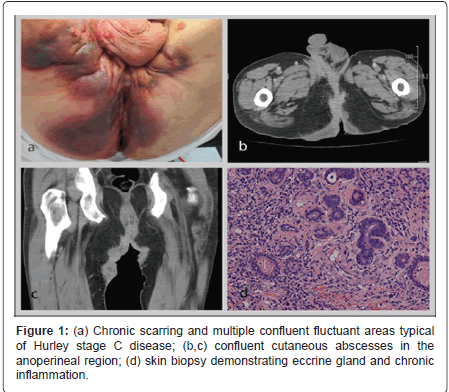Case Report Open Access
An Unusual Differential of Fulminant Perineal Boils
Zhou WX1 and Chua TC1-3*1UNSW Department of Surgery, St George Hospital, Australia
2St George Clinical School, University of New South Wales, Australia
3The Collaborative Research (CORE) Group, Sydney, Australia
- *Corresponding Author:
- Terence Chua
UNSW Department of Surgery
St George Clinical School, Kogarah, NSW 2217, Australia
E-mail: Terence.chua@unsw.edu.au
Received date: April 10, 2013; Accepted date: May 20, 2013; Published date: May 22, 2013
Citation: Zhou WX, Chua TC (2013) An Unusual Differential of Fulminant Perineal Boils. J Gastroint Dig Syst 3:120. doi: 10.4172/2161-069X.1000120
Copyright: © 2013 Zhou WX, et al. This is an open-access article distributed under the terms of the Creative Commons Attribution License, which permits unrestricted use, distribution, and reproduction in any medium, provided the original author and source are credited.
Visit for more related articles at Journal of Gastrointestinal & Digestive System
Lumps and bumps in the perianal region are a common referral for surgical care. In this report, we describe a less common cause of extensive perianal and perineal abscess. The case is of a69-year-old diabetic male who presents with an increasingly painful perineum. He is not overweight, but smokes heavily, and suffers from a long history (20 years) of recurrent flares of suppurative perineal cellulitis. No other significant medical or drug history was elicited. On examination, the affected skin was scarred, hyper pigmented and had multiple discharging sinuses suggesting a chronic inflammatory process. Fluctuant lesions extended from the scrotum anteriorly to the natal cleft posteriorly over a 20cm width around the perineum (Figure 1a). He was afebrile with stable vitals. Laboratory parameters demonstrated a white cell count of 18×109/L and high C-reactive protein. Computed tomographic (CT) imaging was performed to exclude necrotizing fasciitis (Figure 1b and 1c), which demonstrated localized superficial skin induration without crossing of fascia planes. Multiple low attenuation centers were visualized consistent with abscesses. In view of his acute perineal sepsis, he was taken to operating theatre. Under anaesthesia, examination revealed sinuses connecting the multiple abscesses for which all were drained and laid open. Cultures grew streptococcus gallolyticus and staphylococcus aureus. Histological features revealed chronic inflammatory infiltrate and granulation tissue (Figure 1d).Clinical and pathological correlation led to a diagnosis of perineal hidradenitis.
Hidradenitis suppurativa is chronic relapsing inflammation of skin bearing apocrine glands, leading to purulent discharge and progressive scarring. Females dominate males by 3:1, affecting approximately 1% of the general population. Three strongest risk factors are smoking, obesity and coexisting acne, and it is important to consider hyper-androgenic states such as polycystic ovarian syndrome in females as differential. Hidradenitis is most commonly seen in the axilla and anogenital region of both sexes, but also affects the inframammary fold in females. As seen in Figure 1, abscesses with multiple tracts are a hallmark finding of the condition.
Hidradenitis is classified into Hurley Stages. Stage I demonstrates discrete lesions, followed by discrete lesions with scarring or discharging, and lastly stage III with confluent lesions and scarring or discharging. Less severe disease may be managed conservatively with topical and/or oral antibiotics [1,2]. Most patients present with stage II disease, for which surgery is the most successful modality. Common techniques include exteriorization of sinus tracts, excision of scarred and refractory lesions, or wide excision of apocrine gland bearing skin. Wide excision has superior long-term success with few recurrences. In a series of 56 patients undergoing wide excision, 32 patients (57%) underwent delayed healing and 24 patients (43%) underwent delayed skin grafts. Diverting colostomy was necessary in 23 patients (41%). The mean complete healing time was 10 (range, 7-17) weeks in the healing by secondary intention group and six (range, 3-9) weeks in the grafted group [3]. In summary, surgery in perineal hidradenitis is indicated for patients with acute perineal sepsis. In the elective setting, excision and skin grafting may lead to cure. Adjunct care for longterm management includes management of weight, diabetes, smoking cessation and hygiene.
References
- Rambhatla PV, Lim HW, Hamzavi I (2012) A systematic review of treatments for hidradenitis suppurativa. Arch Dermatol 148: 439-446.
- Jemec GB (2012) Clinical practice. Hidradenitis suppurativa. N Engl J Med 366: 158-164.
- Bocchini SF, Habr-Gama A, Kiss DR, Imperiale AR, Araujo SE (2003) Gluteal and perianal hidradenitis suppurativa: surgical treatment by wide excision. Dis Colon Rectum 46: 944-949.
Relevant Topics
- Constipation
- Digestive Enzymes
- Endoscopy
- Epigastric Pain
- Gall Bladder
- Gastric Cancer
- Gastrointestinal Bleeding
- Gastrointestinal Hormones
- Gastrointestinal Infections
- Gastrointestinal Inflammation
- Gastrointestinal Pathology
- Gastrointestinal Pharmacology
- Gastrointestinal Radiology
- Gastrointestinal Surgery
- Gastrointestinal Tuberculosis
- GIST Sarcoma
- Intestinal Blockage
- Pancreas
- Salivary Glands
- Stomach Bloating
- Stomach Cramps
- Stomach Disorders
- Stomach Ulcer
Recommended Journals
Article Tools
Article Usage
- Total views: 16550
- [From(publication date):
June-2013 - Dec 20, 2025] - Breakdown by view type
- HTML page views : 11865
- PDF downloads : 4685

